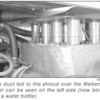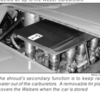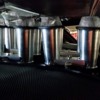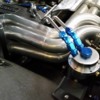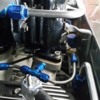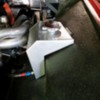Yikes. That's the best you guys got? I'll give you more time to get warmed up. 
Yes. A simple "cookie sheet" is the simplest way to deal with it.
Been there, done that. With Webers, you need as much instant access to them as you can get. That cookie sheet is problematic. You have to get it out of the way first to get to the carbs and linkage.
I used a piece of 1/4" clear lexan bent down with a heat gun and solid covers over the "jet screens" to minimize the water IF the car ever got wet? A clear roof as it were.
The Lexan is mounted to the louvres which open with the decklid so as soon as the deck is open, it is out of the way. You can't make it any faster than that.
One observation here is the height of the velocity stacks. 5" seems to be the right number for this car. The "fuel plume" only seems to rise just over the top of the stock 2-1/2" stacks. 5" keeps it in the stacks and reduces the need for the new fangled "Weber cam".
That certainly did not exist in 1972 for sure.
Curious that I came to the same conclusion as the factory on that? Purely coincidental I'm sure?
I do question the solution of supplying air through snorkels to the direction of the 1/4 window openings though. That would only work if your stick the snorkel completely out of the opening and face them forward.
I feed mine from the sugar scoop. It blows air directly down into the opening in which the Webers live.
Been there, done that. With Webers, you need as much instant access to them as you can get. That cookie sheet is problematic. You have to get it out of the way first to get to the carbs and linkage.
I used a piece of 1/4" clear lexan bent down with a heat gun and solid covers over the "jet screens" to minimize the water IF the car ever got wet? A clear roof as it were.
The Lexan is mounted to the louvres which open with the decklid so as soon as the deck is open, it is out of the way. You can't make it any faster than that.
One observation here is the height of the velocity stacks. 5" seems to be the right number for this car. The "fuel plume" only seems to rise just over the top of the stock 2-1/2" stacks. 5" keeps it in the stacks and reduces the need for the new fangled "Weber cam".
That certainly did not exist in 1972 for sure.
Curious that I came to the same conclusion as the factory on that? Purely coincidental I'm sure?
I do question the solution of supplying air through snorkels to the direction of the 1/4 window openings though. That would only work if your stick the snorkel completely out of the opening and face them forward.
I feed mine from the sugar scoop. It blows air directly down into the opening in which the Webers live.
Attachments
I noticed the oil catch/breather tank factory set up too. Interesting.
I wanted to have a PCV system. Positive vacuum adds 25hp at 10 inches of vacuum. Plus it cleans the sludge out. You will get sludge with the Webers if you do not ventilate the crankcase.
I plumbed this billet tank in between the pcv valve and the vacuum manifold.
If I was going racing, I'd have to add the tank to the inlet side also. For the street, all I need is a controlled "vacuum leak" into the crankcase.
That is done by the billet oil filler cap. It has an air orifice in it. An "air jet" if you like?
With the Webers you need to keep that air orifice about .100" to reduce the vacuum signal loss to the Webers.
This is my oil extractor/catch tank.
Oh. The valve cover needed to be machined to relocate the pcv opening on this end of the cover (and in between the valve springs internally).
I wanted to have a PCV system. Positive vacuum adds 25hp at 10 inches of vacuum. Plus it cleans the sludge out. You will get sludge with the Webers if you do not ventilate the crankcase.
I plumbed this billet tank in between the pcv valve and the vacuum manifold.
If I was going racing, I'd have to add the tank to the inlet side also. For the street, all I need is a controlled "vacuum leak" into the crankcase.
That is done by the billet oil filler cap. It has an air orifice in it. An "air jet" if you like?
With the Webers you need to keep that air orifice about .100" to reduce the vacuum signal loss to the Webers.
This is my oil extractor/catch tank.
Oh. The valve cover needed to be machined to relocate the pcv opening on this end of the cover (and in between the valve springs internally).
Attachments
This is the vacuum manifold hiding under the heat shielding.
Attachments
The factory moved the water tanks around too. I decided that the "overflow" tank was usefull and should be kept but not in the original inaccessible location.
I decided to move it where I could get to it easily. To do that no tanks "off the shelf" even came close.
This tank needed to be fabricated and for me it was easiest to use brass sheet and solder it together.
To get to this shape several mock ups were made from cardboard, then about 30 more changes to make it conform to the space allotted to it.
Everything in the Pantera is subject to the original compound shapes and curves of the original design so solutions are not necessarily simple but when arrived at, to me, seem obvious.
In retrospect, I like this strange boomerang shape.
Everyone has their own opinion but I don't wear Gucci loafers so I'm not bound by the same constraints as the Lamborghini designers are? I actually make the stuff (as pitiful as that might seem to some) but I'm ok with that. I get dirt under my finger nails instead of wearing nail polish. Yucky, I know.
For some inexplicable reason at this very moment, Randy Newman comes to mind...don't know why? "Living in America is really neat...you don't need to run through the jungle and scrape up your feet?" Hum? Now why did I say that? Sorry...beats me?
Any of this stuff is removable with a couple of screws and the car is returnable to it's original bland configurations? Boring as they are. Some like that. Go figure...right?
Oh...there is additional stainless heat shielding that is not in place in these pictures.
I decided to move it where I could get to it easily. To do that no tanks "off the shelf" even came close.
This tank needed to be fabricated and for me it was easiest to use brass sheet and solder it together.
To get to this shape several mock ups were made from cardboard, then about 30 more changes to make it conform to the space allotted to it.
Everything in the Pantera is subject to the original compound shapes and curves of the original design so solutions are not necessarily simple but when arrived at, to me, seem obvious.
In retrospect, I like this strange boomerang shape.
Everyone has their own opinion but I don't wear Gucci loafers so I'm not bound by the same constraints as the Lamborghini designers are? I actually make the stuff (as pitiful as that might seem to some) but I'm ok with that. I get dirt under my finger nails instead of wearing nail polish. Yucky, I know.
For some inexplicable reason at this very moment, Randy Newman comes to mind...don't know why? "Living in America is really neat...you don't need to run through the jungle and scrape up your feet?" Hum? Now why did I say that? Sorry...beats me?
Any of this stuff is removable with a couple of screws and the car is returnable to it's original bland configurations? Boring as they are. Some like that. Go figure...right?
Oh...there is additional stainless heat shielding that is not in place in these pictures.
Attachments
Add Reply
Sign In To Reply


